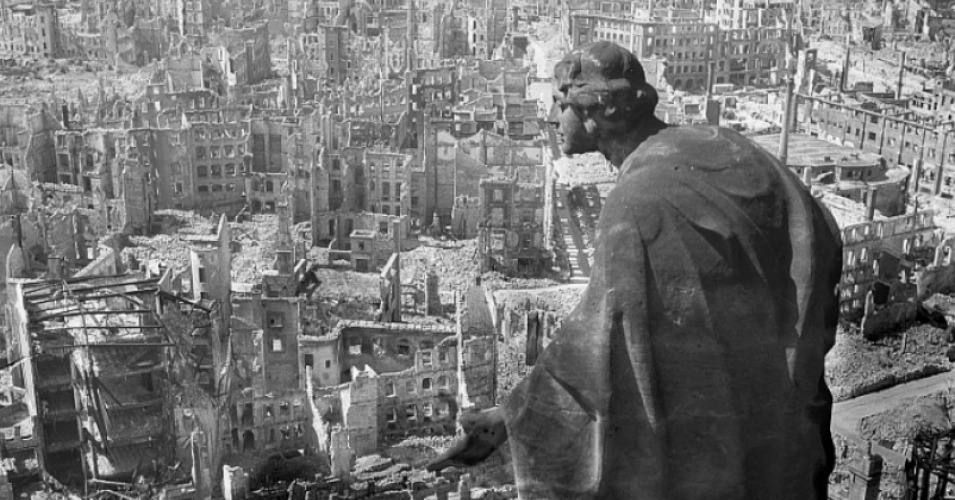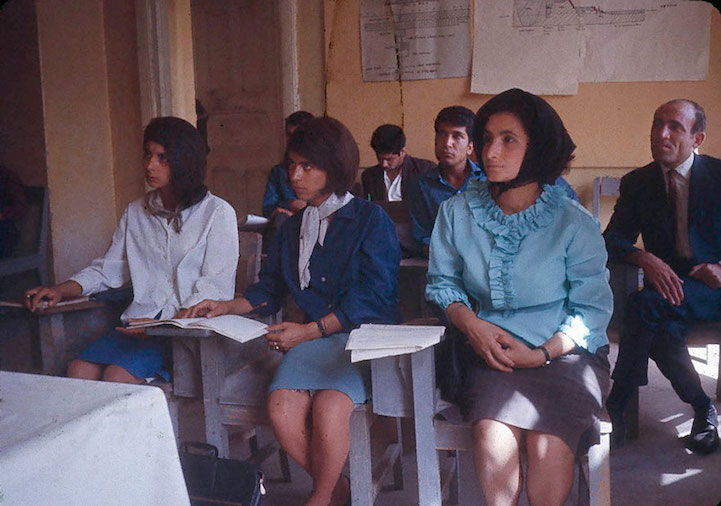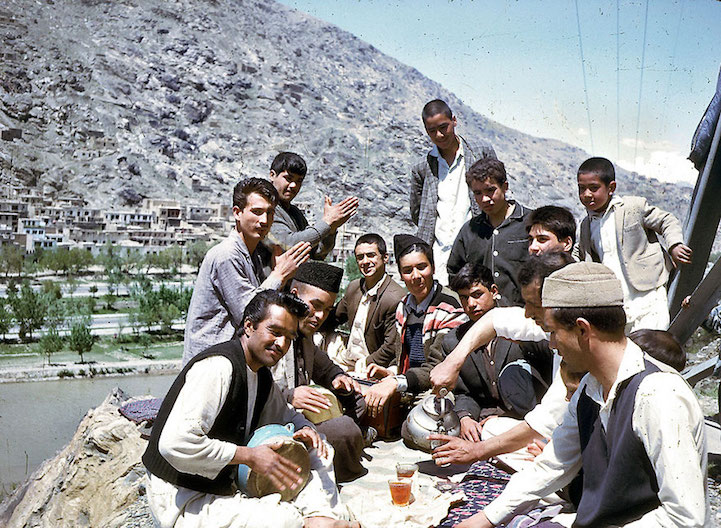
Tomorrow is the 75th anniversary of the Allied bombing of Dresden, Germany, which incinerated tens of thousands of people – the vast majority of them civilians – in the closing days of the war in Europe. Below is an article by Brett Wilkins about the bombing. – Natylie
The Beasts and the Bombings: Reflecting on Dresden, February 1945
The Dresden bombing shocked the world’s conscience.
The Allied destruction of Dresden wasn’t the biggest or deadliest aerial bombardment of a German city during World War II. But it is by far the most infamous, largely due to Kurt Vonnegut’s anti-war masterpiece Slaughterhouse-Five. February 13 marks the 75th anniversary of what Vonnegut, who survived the bombing as a prisoner-of-war, called “carnage unfathomable.”
Butcher Harris and British Terror Bombing
By early 1945 the once-unstoppable German army was in retreat on all fronts. Its desperate last-ditch counteroffensives against the rapidly advancing Allied forces in the west—the Battle of the Bulge and Operation Baseplate—had failed, while in the east the Red Army rolled into German territory during the first Silesian Offensive. The time was right, British commanders argued, for large-scale aerial attacks on cities in eastern Germany that would aid the Soviet offensive and crush German morale.
Long before this time the British had implemented a policy of what they called “terror bombing,” or the total deliberate destruction of German cities, as a method of breaking the will of the German people to continue fighting. Waves of Royal Air Force (RAF) warplanes bombed densely populated cities under cover of night, abandoning any pretense of precision targeting and causing widespread, indiscriminate death and destruction. The chief of the RAF Bomber Command, Arthur “Bomber” Harris, declared his desire to visit “the horrors of fire” on the German people. Once Harris was pulled over by a British police officer for speeding in his black Bentley. “You could have killed someone,” the constable admonished him. “Young man,” the commander retorted, “I kill thousands of people every night.”
In 1943, Harris wrote that “the aim is the destruction of German cities, the killing of German workers and the disruption of civilized life throughout Germany” while “downplaying the obliteration of German cities and their inhabitants.”
He wasn’t lying. Although the British government insisted that it was never its policy to target civilians, the truth was something altogether different. As Harris said after Luftwaffe bombers blitzed British cities, since the Germans had “sown the wind” they should “reap the whirlwind.” In 1943, Harris wrote that “the aim is the destruction of German cities, the killing of German workers and the disruption of civilized life throughout Germany” while “downplaying the obliteration of German cities and their inhabitants.”
“Bomber” was indeed a fitting nickname for Harris, but his men had another one for him — “Butcher.” He lived up to the moniker. Around 50 German cities were subjected to horrific aerial bombardment, often with incendiary bombs designed to spark massive firestorms and maximize death, destruction and terror. In July 1943, some 45,000 civilians including 21,000 women and 8,000 children died during more than a week of relentless bombing in Hamburg. In February 1945 hundreds of Lancaster bombers leveled Pforzheim, killing nearly a third of the population. The list went on and on.
‘Fire, Only Fire’
Harris and other RAF commanders proposed simultaneous attacks on Berlin, Chemnitz, Dresden and Leipzig in the winter of 1945. Dresden, Germany’s seventh-largest city, was the largest urban area in the Third Reich that hadn’t yet been bombed. It had been spared from Allied attack because it was an important cultural city — known as the Jewel Box for its celebrated architecture — with relatively few significant military targets. It was a city of refuge, with 19 hospitals and more than a million refugees fleeing the horrors of the Red Army advance encamped there. They were drawn by Dresden’s reputation as a safe haven from the flames of war that had engulfed most of the rest of Germany, a reputation reinforced by the presence of some 25,000 Allied prisoners of war held in and around the city.
The first RAF warplanes approached the city after 9:30 p.m. on February 13. Some 200,000 incendiary bombs along with 500 tons of high-explosive munitions including two-ton “blockbuster” bombs were dropped during the initial raids, sparking thousands of fires that could be seen from 500 miles (800 km) away in the air. The heat generated by the inferno melted human flesh, turning many victims into piles of goop. Men, women, children, the sick, the elderly, refugees and Allied POWs and even the animals in the city zoo — all were incinerated together. The 2700º Fahrenheit (1480° C) firestorm sucked all the oxygen from the air; many thousands suffocated to death. Lothar Metzger, who was nine years old at the time, later recalled:
About 9:30 p.m. the alarm was given. We children knew that sound and… hurried downstairs into our cellar… My older sister and I carried my baby twin sisters, my mother carried a little suitcase and the bottles with milk for our babies. On the radio we heard with great horror the news: “Attention, a great air raid will come over our town!” … Some minutes later we heard a horrible noise — the bombers. There were nonstop explosions. Our cellar was filled with fire and smoke and was damaged, the lights went out and wounded people shouted dreadfully. In great fear we struggled to leave this cellar…
We did not recognize our street any more. Fire, only fire wherever we looked… It was beyond belief, worse than the blackest nightmare. So many people were horribly burnt and injured. It became more and more difficult to breathe… Inconceivable panic. Dead and dying people were trampled upon… cremated adults shrunk to the size of small children, pieces of arms and legs, dead people, whole families burnt to death, burning people ran to and fro, burnt coaches filled with civilian refugees, dead rescuers and soldiers, many were calling and looking for their children and families, and fire everywhere, everywhere fire, and all the time the hot wind of the firestorm threw people back into the burning houses they were trying to escape from… The twins had disappeared… we never saw my two baby sisters again.
The following morning, a wave of more than 300 United States Army Air Force Boeing B-17 Flying Fortress bombers pounded the survivors with over 700 tons of explosives. On February 15, US warplanes bombed the city’s southeastern suburbs, as well as the nearby towns of Meissen and Prina. By the time it was all over, some 25,000 men, women and children were dead and nearly 90 percent of the homes in central Dresden were obliterated. Many of the targets that could have been considered of military interest — a few factories, the railway system — remained relatively unscathed. Nazi military trains were chugging through the city again within three days of the bombing.
‘Are We Beasts?’
British and American officials insisted Dresden was chosen as a target because of its industrial and transportation infrastructure. This is only partially true. On the eve of the bombing, the Red Army was a mere 80 miles (130 km) from Dresden and the US and Britain, knowing that Europe would be carved up between themselves and the Soviets after the war, wanted to impress Stalin with a massive show of force. An RAF memo to airmen the night of the attack explained that “the intentions of the attack are to hit the enemy where he will feel it most” and “to show the Russians when they arrive what Bomber Command can do.” A few months later, the United States would wage the world’s first and only nuclear war, obliterating two Japanese cities and killing hundreds of thousands of their people, in what was partly yet another bid to shock and awe the Soviets.
The Dresden bombing shocked the world’s conscience. Churchill, not known for outpourings of compassion, was appalled by the savagery of the attack, calling it “an act of terror and wanton destruction.” After seeing photographs of the devastated city, the prime minister asked, “Are we beasts? Are we taking this too far?” In a top secret memo dated March 28, 1945, he wrote:
It seems to me that the moment has come when the question of bombing of German cities simply for the sake of increasing the terror, though under other pretexts, should be reviewed. Otherwise we shall come into control of an utterly ruined land.
Others defended the bombing. “Butcher” Harris acknowledged that “the destruction of so large and splendid a city at this late stage of the war was considered unnecessary even by a good many people who admit that our earlier attacks were fully justified.” However, he asserted that terror bombing would “shorten the war and preserve the lives of Allied soldiers.” Harris infamously added: “I do not personally regard the whole of the remaining cities of Germany as worth the bones of one British grenadier.”
As many as 600,000 German civilians were killed by Allied bombing over the course of the war. Many of these victims died during the war’s final months, when Germany’s defeat was certain and such slaughter served no valid military purpose. And while the Nazis may have started the air war by bombing British cities, killing 14,000 civilians during the Blitz, the whirlwind they reaped—to paraphrase Harris—was so grossly disproportionate that it would forever stain the Allies’ self-righteous claims of having waged the “last good war.”
Brett Wilkins is a San Francisco-based freelance author and editor-at-large for US news at Digital Journal. His work, which focuses on issues of war and peace and human rights, is archived at www.brettwilkins.com.
Our work is licensed under a Creative Commons Attribution-Share Alike 3.0 License. Feel free to republish and share widely.


